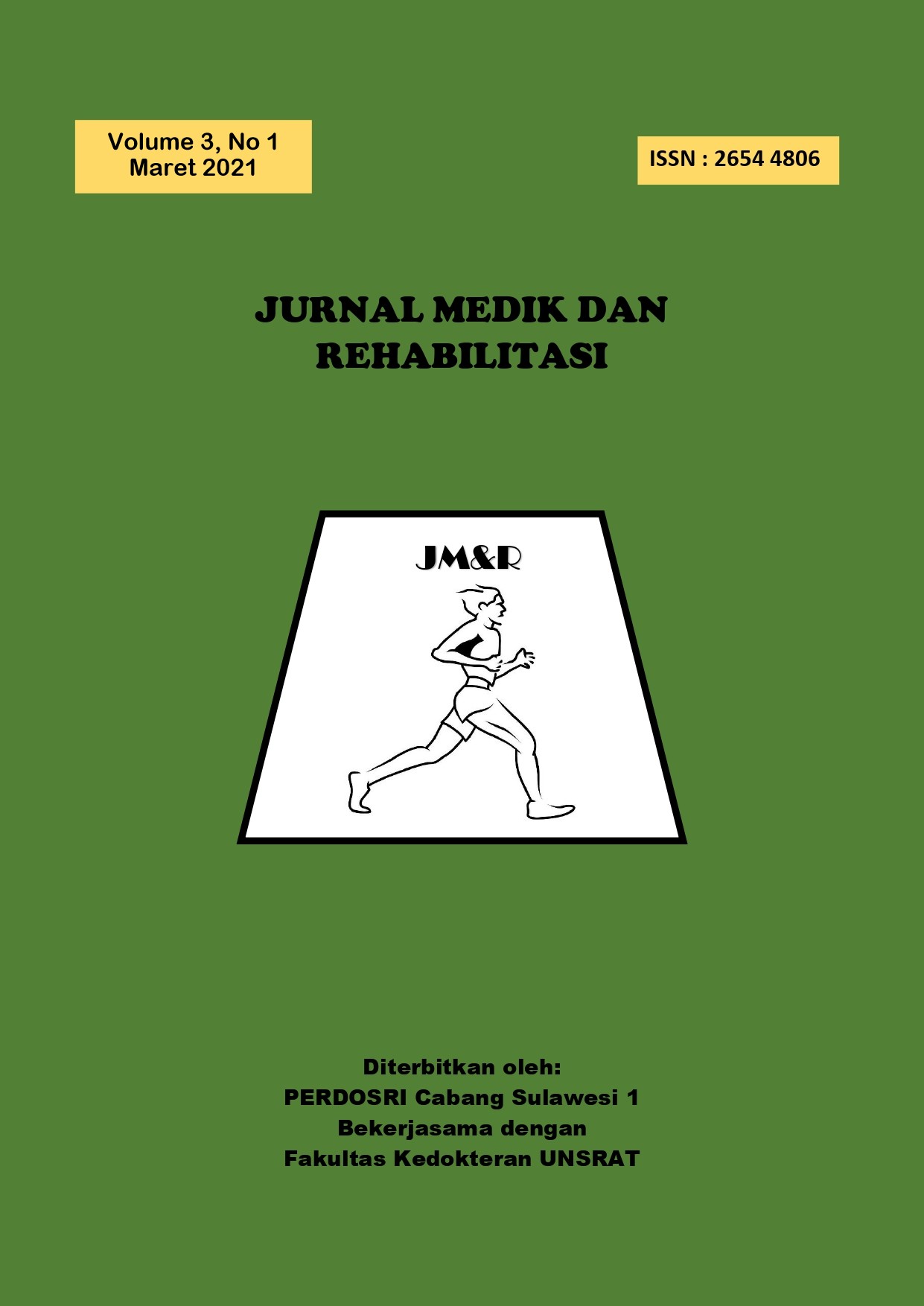DUCHENE MUSCULAR DISORDER
Abstract
Duchenne muscular dystrophy (DMD) merupakan suatu penyakit X-linked resesif, salah satu tipe muskular dystrophy yang paling sering terjadi pada anak-anak, progresif cepat dystrophy otot, bersifat herediter dan diturunkan melalui X-linked resesif sehingga hanya mengenai pria, sedangkan perempuan sebagai karier.
Sekitar 74%-80% onset DMD terjadi sebelum usia 4 tahun. Namun sebagian besar kasus terjadi pada usia 5-6 tahun. Gejala klinis yang khas pada pasien DMD yaitu kelemahan otot-otot proksimal, calf hypertrophy dan Gower’s Sign.1 Kematian biasanya terjadi akibat insufisiensi respiratori kronis dan atau gagal jantung.
Penatalaksanaannya dapat berupa medikamentosa, nutrisional, rehabilitasi medik dan tindakan pembedahan. Peran rehabilitasi medik penting untuk mengurangi progresifitas penurunan fungsi otot dan kemampuan fungsional yang secara sekunder terjadi akibat adanya penurunan aktivitas fisik pada penderita DMD, meminimalkan problem kontraktur, komplikasi kardiorespirasi dan meningkatkan kapasitas fisik.
References
Jeffrey S. Chamberlain TAR, editor. Duchenne Muscular Dystrophy Advances in Therapeutics. New York: Taylor & Francis Group; 2016. p. 1-16.
Centers for Disease Control and Prevention (CDC). Prevalence of Duchenne/Becker muscular dystrophy among males aged 5-24 years - four states, 2007. MMWR Morb Mortal Wkly Rep. 2009 Oct 16;58(40):1119-22.
Mah JK, Korngut L, Dykeman J, Day L, Pringsheim T, Jette N. A systematic review and meta-analysis on the epidemiology of Duchenne and Becker muscular dystrophy. Neuromuscul Disord. 2014;24(6):482-491.
Petrus N, Lumbantobing SM. Penyakit unit motor dan sindrom neurocutan. Dalam Soetomenggolo TS, Sofyan I. Buku ajar neurologi Anak. Jakarta. Ikatan Dokter Anak Indonesia. 2009: 287-8.
Jansen M, Groot IJd, Alfen Nv, Geurts AC. Physical training in boys with Duchenne Muscular Dystrophy: the protocol of the No Use is Disuse study. biomedcentral pediatric. 2010:3-15.
Gianola S, Pecoraro V, Lambiase S, Gatti R, Banfi G, Moja L. Efficacy of Muscle Exercise in Patients with Muscular Dystrophy: A Systematic Review Showing a Missed Opportunity to Improve Outcomes. PLOS ONE. 2013;8(6).
Grange RW, Call JA. Recommendations to Define Exercise Prescription for Duchenne Muscular Dystrophy. American College of Sports Medicine. 2017;35:12-16.
Sarnat HB. Developmental Disorders of Muscle. In: Kliegman RM, Stanton BF, Schor NF, Geme JWS, Behrman RE, editors. Nelson Textbook of Pediatric. 19 ed. Philadelphia: Elsevier; 2011. p. 2119-2128.
Deconinck N, Dan B. Pathophysiology of Duchenne muscular dystrophy: Current hypotheses. Pediatr Neurol 2007;36:1-7.
Bushby K, Finkel R, Birnkrant DJ, Case LE, Clemens PR, Cripe L, et al. Diagnosis and management of Duchenne muscular dystrophy, part 1: diagnosis, and pharmacological and psychosocial management. 2012
Bushby K, et al. The Diagnosis and Management of Duchenne Muscular Dystrophy, part 1: diagnosis, and pharmacological and psychosocial management, Lancet Neurology 2010, 9(1) 77-93.
Palmieri B, Sblendorio V, Ferrari A, Pietrobelli A. Duchenne muscle activity evaluation and muscle function preservation: is it possible a prophylactic strategy? obesity reviews. 2008:121-139
McDonald CM, Han JJ, Carter GT. Myopathic Disorder. In: Braddom RL, editor. Physical Medicine and Rehabilitation. 4 ed. Philadelphia: Elsevier Saunders; 2011. p. 1097-1098.
Preston DC, Saphiro BE, editors. Electromyography and neuromuscular disorder Clinical electrophysiological correlation. 2 ed. Phyladelphia: Elsevier; 2015. p. 575-586.
Amato AA, Russel JA. Neuromuscular Disorders. Columbus:The McGraw-Hill Companies, Inc. 2008: 529-737.
Barner M, Good D. Hand book of clinical neurology. 2 ed. Philadelphia: Elsevier; 2010.
Matthews DJ. Muscular Dystrophy: Duchenne. In: Buschbacher RM. Rehabilitation Medicine Quick Reference Pediatrics. Demos Medical. NewYork. 2011. 143-4.
Bushby K, Finkel R, Birnkrant DJ, Case LE, Clemens PR, Cripe L, et al. Diagnosis and management of Duchenne muscular dystrophy, part 1: diagnosis, and pharmacological and psychosocial management. 2012.
Yen-Mou Lu and Yi-Jing Lue. Strength and Functional Measurement for Patients with Muscular Dystrophy, Muscular Dystrophy. 2012.
Shepherd R.B. Physiotherapy in pediatrics. London. William Heimann medical books limited.
Bach J.R, lieberman JS. Rehabilitation of the patient with disease affecting the motor unit. In: Delisa JA. Rehabilitation medicine: principle and practice. Second edition. Philadelphia. Lippincott Co. 2013:1099-106.
Perhimpunan Dokter Spesialis Kedokteran Fisik dan Rehabilitasi Indonesia. Panduan pelayanan klinis kedokteran fisik dan rehabilitasi. Jakarta: PB Perdosri; 2012.
Kisner C, Colby LA. Therapeutic Exercise Foundations and Techniques. In. 5 ed. Philadelphia: Davis Company; 2012.
Thomson WR, Gordon NF, Pescatello LS. ACSM’s Guidelines for exercise testing and prescription. 8 Ed. Lippincot William & Willkins. 2009.
Sheila E, editor. Practical manual of physical medicine and rehabilitation. Mosby, inc. 2008.
Jansen M, Groot IJd, Alfen Nv, Geurts AC. Physical training in boys with Duchenne Muscular Dystrophy: the protocol of the No Use is Disuse study. BMC Pediatrics. 2010:1-15.
Sayers SP. The Role of Exercise as a Therapy for Children with Duchenne Muscular Dystrophy. Pediatric Exercise Science. 2000;12:23-33.
Barner M, Good D. Hand book of clinical neurology. 2 ed. Philadelphia: Elsevier; 2010.
Emery AEH, Muntoni F, Quinlivan R. Duchene Muscular Dystrophy. In. 4 ed. New York: Oxford University Press; 2015.
Stein J. Duchenne muscular dystrophy: A guide for families with a child aged 5 – 12 years. Oxford Muscle Centre. 2015
Posselt H, Denny B. Aquatic physiotherapy. Brisbane. 2016

